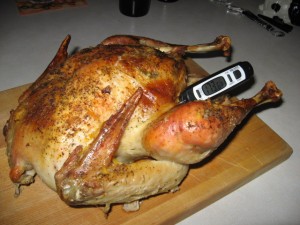Surveys still suck, but they can give an indication of food safety practices to investigate more rigorously.
The Australian Food Safety Information Council has released national survey data that shows 60% of home cooks in Australia are putting themselves at additional risk of food poisoning by washing whole poultry before it is cooked which spreads bacteria around the kitchen. A further 16% of those surveyed incorrectly tasted chicken to see if it is cooked properly rather than use a safe and accurate meat thermometer.
Food Safety Information Council Chairman, Dr Michael Eyles, says 6 in 10 home cooks in a national Newspoll survey washed whole chicken before they cooked it,  with 5 in 10 washing chicken pieces with skin on and 4 in 10 washing skinless chicken pieces.
with 5 in 10 washing chicken pieces with skin on and 4 in 10 washing skinless chicken pieces.
“According to a Food Standards Australia New Zealand survey 84% of raw chicken carcasses tested positive to the food poisoning bacteria Campylobacter and 22% to Salmonella. This is similar to the findings of other surveys overseas. Notified cases of illness from Campylobacter and Salmonella in Australia have almost doubled over the last 20 years. OzFoodnet estimates there are approximately 220,000 cases of Campylobacter infection each year with more than 75% transmitted by food and 50,000 cases of Campylobacter infection each year can be attributed either directly or indirectly to chicken meat.
”Home cooks are probably following what their parents or grandparents did in the past by washing poultry, not to mention probably patting it dry with a tea towel. Washing poultry splashes these bacteria around the kitchen cross contaminating sinks, taps, your hands, utensils, chopping boards and foods that aren’t going to be cooked like salads or desserts.
“Cooking poultry right through kills these bacteria, making it safe. However, 16% of those surveyed, rather than using a meat thermometer or checking if juices run clear  and are no longer pink, say they eat some chicken to see if tastes cooked, with males significantly more likely to do this than females,’ Dr Eyles concludes.
and are no longer pink, say they eat some chicken to see if tastes cooked, with males significantly more likely to do this than females,’ Dr Eyles concludes.
Color is still a lousy indicator of safety, but at least they mention thermometers.
Any agency that wants to say it’s science-based should provide credible evidence; otherwise it’s just another food huckster hiding behind the impartir of science. Consumers can handle more information, not less, and some credible references would boost, uh, credibility.
